I participated in an event called "Tokyo Metropolitan High Watching" (May 29).
This is one of the measures related to facility safety implemented by the Metropolitan Expressway, which walks under the elevated tracks along the Metropolitan Expressway to have a monitor monitor observe the overall road facilities, and at the same time to understand daily maintenance work, It is to gather opinions on aspects and services.
Meet at the Metropolitan High Management Bureau Building in Nihonbashihakozakicho, walk along the road from Hakozaki Junction (JCT) under the Metropolitan Expressway No. 9 Fukagawa Line, and walk about 2 km to Kiba, Koto-ku.
I looked up from the road under the overpass and looked at the structures, but until now I had never seen these structures seriously, so it was a fresh experience in a sense.
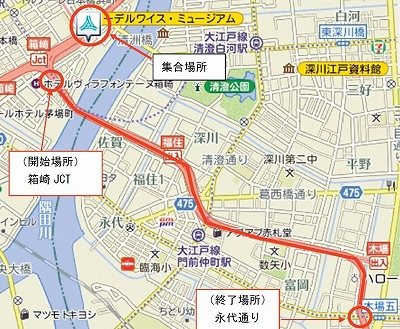 The starting point, Hakozaki JCT, is a junction of a car connected to No. 6 Mukojima Line and No. 9 Fukagawa Line, and the Sumida River Ohashi immediately after JCT is directly connected to JCT, so it is quite complicated. You can see that it is a structure.
The starting point, Hakozaki JCT, is a junction of a car connected to No. 6 Mukojima Line and No. 9 Fukagawa Line, and the Sumida River Ohashi immediately after JCT is directly connected to JCT, so it is quite complicated. You can see that it is a structure.
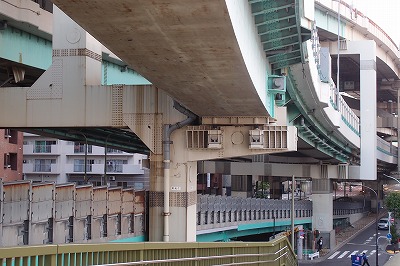 Crossing the Sumida River, you will enter the Fukagawa area of Koto-ku, pass through Fukagawa Fudodo and Tomioka Hachimangu Shrine and finish at Kiba.
Crossing the Sumida River, you will enter the Fukagawa area of Koto-ku, pass through Fukagawa Fudodo and Tomioka Hachimangu Shrine and finish at Kiba.
On the way, check if there are bird nests or things that are likely to fall, and listen to stories about the structure and materials of the bridge.......It was a precious time.
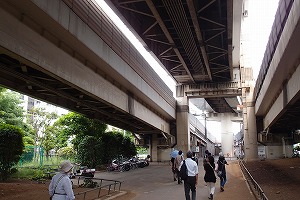
The Metropolitan Expressway was created using many places of rivers and waterways that have been used as water transportation since the Edo and Meiji eras.
Compared to the old map, it can be seen that the Metropolitan Expressway course that we walked this time was made at the Hakozaki River on the Chuo-ku side and the oil Horikawa on the Koto-ku side.
Due to these circumstances, there are many places that are elevated, and it is necessary to give more consideration to the safety of cars, people and ships passing underneath them.
I think the engineers who made it were also difficult, but I realized that maintaining and maintaining this was also a difficult task.
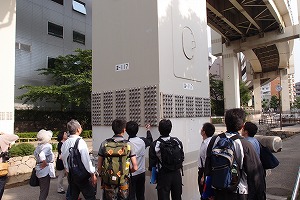
After watching, it is a waste to return home as it is, so go back and walk along the original road.
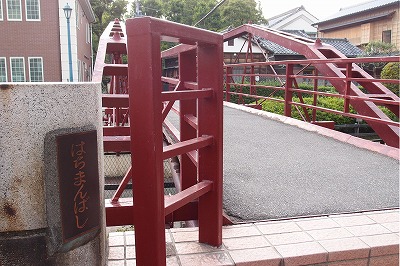
Hachiman Bridge is located east of Tomioka Hachimangu Shrine.
This bridge was relocated from one of the "Mitsuhashi" in Chuo-ku, "Bunshobashi", and was built in 1878. It is the oldest bridge in Japan made from iron and is an important cultural property of the country. It was relocated here after the Great East Japan Earthquake, but is still in use.
A part of the bridge is decorated with chrysanthemum emblems, making it a quaint bridge.
Finally, "Sumida River Ohashi".
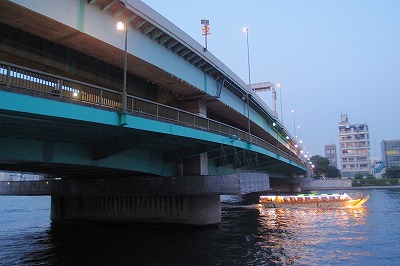 The lower part of this bridge is a two-layer bridge with a general road and the upper part is a metropolitan height, and the landscape requires wisdom and ingenuity. However, the view from this bridge is impressive.
The lower part of this bridge is a two-layer bridge with a general road and the upper part is a metropolitan height, and the landscape requires wisdom and ingenuity. However, the view from this bridge is impressive.
The upstream Kiyosu Bridge area is one of the few spots where the Sky Tree can be seen in the middle of the Sumida River, and the downstream area of Eitai Bridge fits well with the view of the bridge.
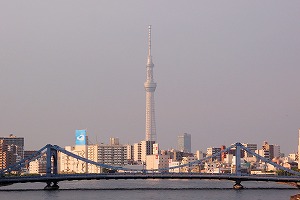
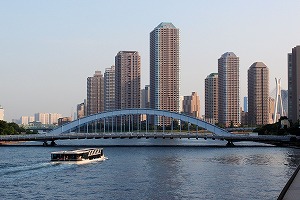
I personally like the scenery.
In the area of Kiyosubashi, especially when the Sky Tree, which is several times a year, turns pink. It happened to be pink on the day. It harmonizes with the pink light-up of Kiyosu Bridge.
In the direction of Eitai Bridge, was the sky slightly blue after sunset? You can feel the light blue light of Eitai Bridge more beautifully.
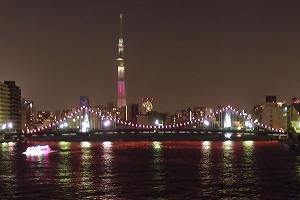
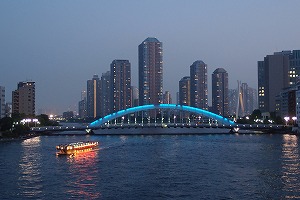
Cheongju Bridge and Eitai Bridge are lit up from evening until 21:00. The nearest station to Sumida River Ohashi is Suitengumae Station, and Ningyocho Station is also within walking distance.

